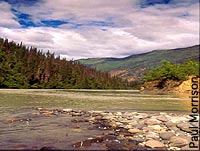
News |
- Celebrate Blue October
- Polar Bears' Climate Change Risk Growing
- More Wind Power for Manitoba
- Court Case to Protect BC Caribou
- UN Declaration on the Rights of Indigenous Peoples
- CEC Hearings for OlyWest Hog Plant
- Climate Crisis Action - Youth Coalition
- WWF Calls for Fishing Reforms
- Climate Plan Workshop Coming to Winnipeg
- Ethanol Plant Causes Water Shortages
- California Passes Climate Change Legislation
- Coalition Takes EPA to Court About GHGs
| Celebrate Blue October | 27 September 06 |
 Blue October is an international month of action to challenge corporate control of water and to protect water as a shared natural resource available to all. The Council of Canadians leads Blue October in Canada, and supports the campaign throughout our hemisphere. Blue October is an international month of action to challenge corporate control of water and to protect water as a shared natural resource available to all. The Council of Canadians leads Blue October in Canada, and supports the campaign throughout our hemisphere. Globally today, one in 6 people lack access to safe, affordable water, and 2 in 5 lack access to adequate sanitation. The United Nations expects these numbers to rise - unless we act now. Amid this crisis, some of the world's wealthiest corporations are looking to profit, often at the expense of the poor. A vibrant international movement is challenging the corporate control of this precious resource, and defending water as a public good and an inalienable right. The Blue October campaign website includes information on events happening all over the world in October 2006. Help make Blue October a success by organizing an action or event, big or small! Visit the Blue October campaign website Source: Blue October Campaign |
|
| Polar Bears' Climate Change Risk Growing | 22 September 06 |
 The retreat of sea ice in the Arctic is forcing the world's wild polar bear population into an unnatural fast which speeds up threats associated with climate change. The retreat of sea ice in the Arctic is forcing the world's wild polar bear population into an unnatural fast which speeds up threats associated with climate change.Scientists are now saying that earlier annual break-up of sea ice is cutting short the spring hunting season for bears. Polar bears are completely dependent on sea ice for their essential needs, including hunting their prey of seals. Female bears rely on spring hunting season to build fat reserves needed to see them through summer months. The retreating ice means they have not had time to build up normal levels of fat - which can reach a thickness of 12cm. As females become thinner, they are more susceptible to disease. Their ability to reproduce and the survival chances of their cubs decline significantly. The loss of sea ice has caused the polar bear population in Western Hudson Bay to decline from approximately 1,200 bears in 1987, to 1,100 bears in 1997, and then to fewer than 950 bears in 2004. The US court case against the federal government initiated December 2005 by the Center for Biological Diversity, NRDC, and Greenpeace was settled on June 29th, 2006. The US Fish and Wildlife Service has until December 27, 2006 to complete its "12-month" finding as to whether polar bears will be listed under the Endangered Species Act. View the September 15, 2006 Independent Online (UK) article View the Center for Biological Diversity web page on the Polar Bear View the February 6, 2006 Manitoba Wildlands news item Sources: Independent Online (UK), Center for Biological Diversity |
|
| More Wind Power for Manitoba | 20 September 06 |
 The Government of Manitoba announced September 7, 2006 that it will be issuing a Request for Proposals (RFP) for 300 megawatts (MW) of wind power this winter. The Government of Manitoba announced September 7, 2006 that it will be issuing a Request for Proposals (RFP) for 300 megawatts (MW) of wind power this winter. The RFP for 300 MW of wind follows on an earlier request for interest for 1,000 MW of wind power, which generated over 40 responses from wind developers, First Nations, communities, turbine manufacturers and consultants. The government is projecting that construction of the new wind projects could begin as early as 2007 or 2008. Manitoba Energy, Science and Technology Minister Dave Chomiak also announced three further allocations of 200 MW of wind power for 2013-14, 2015-16, and 2017-18, based on economic viability. These future phases of Manitoba's wind strategy will include smaller, community-based wind projects where individuals such as farm producers or other community groups can sell power back into the energy grid. Earlier this summer, the Department of Energy, Science and Technology released a report describing Manitoba's past and present energy generation and consumption data. It was not clear how power from current wind projects under way (Killarney, Dacotah and Pembina Hills), fit into Manitoba Government projections for 1,000 MW of wind power over ten years. Manitoba to date does not have environmental assessment standards for wind projects. Steps to amend the classes of regulation under the Environment Act for wind projects appear to be on hold. View the September 7, 2006 Manitoba Government press release View the July 13, 2006 Manitoba Government press release View the June 2006 report, Energy in Manitoba (PDF) Source: Government of Manitoba |
|
| Court Case to Protect BC Caribou | 20 September 06 |
 Environmental groups opposing the proposed Tulsequah Chief mine initiated a legal challenge saying the project could wipe out a protected caribou herd. The Sierra Legal Defence Fund is targeting Transport Canada and the Department of Fisheries and Oceans in the suit. Environmental groups opposing the proposed Tulsequah Chief mine initiated a legal challenge saying the project could wipe out a protected caribou herd. The Sierra Legal Defence Fund is targeting Transport Canada and the Department of Fisheries and Oceans in the suit.The lawsuit, filed August 23, 2006, is asking Canada's Federal Court to ensure the federal government upholds its legal duty to protect the East Atlin caribou herd. The project involves reopening the Tulsequah Chief mine to extract copper, gold and other metals and includes construction of a 160-kilometre road in the Taku watershed, in what is one of the largest roadless areas in North America. The 800-1,000-head herd roams the BC-Yukon border region. It is part of the Northern Mountain population of Woodland Caribou listed as a species of special concern under the act. "Canadian Wildlife Service, Yukon Government and independent scientists all agree that the impacts from this project would be devastating on the caribou," said David MacKinnon, executive director of the Transboundary Watershed Alliance in a news release. View the August 24, 2006 Sierra Legal Defense Fund press release View the August 24, 2006 Canadian Press article on Canada.com View previous Manitoba Wildlands news items; May 31, 2005 & March 3, 2005 Sources: Sierra Legal Defense Fund, Canadian Press |
|
| UN Declaration on the Rights of Indigenous Peoples | 20 September 06 |
 After more than two decades of negotiation and debate, the United Nations is moving forward with global human rights standards to protect the rights of Indigenous Peoples. After more than two decades of negotiation and debate, the United Nations is moving forward with global human rights standards to protect the rights of Indigenous Peoples. The draft UN Declaration on the Rights of Indigenous Peoples was adopted by the UN Human Rights Council at its historic first meeting June 2006. The Declaration must now be adopted by the UN General Assembly to become part of the body of international human rights standards. The draft Declaration affirms the right of Indigenous peoples to have meaningful control over their own lives, to maintain their distinct cultural identities for future generations, and to have secure access to the lands and natural resources essential to their ways of life. Canada, United States, Russia, New Zealand and Australia have opposed the adoption of the Declaration. A global petition, co-hosted by the Grand Council of the Crees (Eeyou Istchee) and Amnesty International Canada, is being circulated and will be used to promote adoption of the Declaration by the U.N. General Assembly. View and sign the Grand Council of the Crees / Amnesty International: Petition on the UN Declaration on the Rights of Indigenous Peoples Visit Amnesty International's website on this UN Declaration View the UN Human Rights Council web page for its inaugural June 2006 meeting View Manitoba Wildlands' July 26, 2006 news item regarding this UN Declaration Sources: Amnesty International Canada, Grand Council of the Crees |
|
| CEC Hearings for OlyWest Hog Plant | 14 September 06 |
 On August 29, 2006, the Manitoba Minister of Conservation requested the Clean Environment Commission (CEC) conduct a public environmental hearing regarding the OlyWest Hog Processing Plant proposal. The hearing is to consider the Proposal and receive public comments and concerns. On August 29, 2006, the Manitoba Minister of Conservation requested the Clean Environment Commission (CEC) conduct a public environmental hearing regarding the OlyWest Hog Processing Plant proposal. The hearing is to consider the Proposal and receive public comments and concerns.The Minister of Conservation also released Terms of Reference for the CEC hearing and announced that participant funding in the amount of $100,000 is to be made available to intervenors. The public has until September 30th (30 days) to appeal the Terms of Reference and/or the amount of participant funding available to intervenors. An advice document containing environmental standards which OlyWest must address through their environmental impact statement underwent public review and the final version was released June 13, 2006. Public comments on the draft advice document have not been placed in the Public Registry. No response or indication of how public comments on the draft advice document are incorporated into or reflected in the final advice document has been filed in the Public Registry file for the OlyWest project (PR File #5155.00). Manitoba Conservation has also not posted public comments or proponent response to public comments on-line. View CEC Current Hearings page on the OlyWest Hog Processing Plant View the Terms of Reference for CEC OlyWest hearing (PDF) Visit Manitoba Environmental Assessment and Licencing Branch page for OlyWest Plant View OlyWest's Environment Act Proposal and Environmental Impact Statement View Final advice document for Preparation of Environment Act Proposal for a New Hog Processing Plant in Winnipeg (PDF) View past 2006 Manitoba Wildlands news items: July 20 - Confusion Over OlyWest Hearings May 1 - Opposition to Winnipeg Hog Plant Gains Momentum Sources: Clean Environment Commission, Manitoba Environmental Assessment and Licencing Branch |
|
| Climate Crisis Action - Youth Coalition | 14 September 06 |
 Over 50 young leaders from organizations across the country met September 8 - 10, 2006 to launch the Canadian Youth Climate Coalition. In the face of government inaction, youth are demanding leadership and immediate action. Over 50 young leaders from organizations across the country met September 8 - 10, 2006 to launch the Canadian Youth Climate Coalition. In the face of government inaction, youth are demanding leadership and immediate action."It is a very powerful and diverse group of passionate youth who have never worked together before," said Jessica Simpson of the Arctic Indigenous Alliance. "We could immediately agree on one thing: addressing climate change should be a priority for our government, for industry, and for ours and all future generations." A spokesman for federal Environment Minister Roma Ambrose attempted to dismiss the Canadian Youth Climate Coalition, "These groups are politically motivated," Ryan Sparrow said in a telephone interview from Ottawa. "Our government will deliver real action on Canada's environment. We're all Canadians, not just special interest groups." However, the organizations who supported the youth summit included student societies, private sector companies, unions, aboriginal and Métis groups, human-rights groups, faith groups, and environmental groups - that can't be simply dismissed either as 'politically motivated' or 'special interest groups'. Polls show that more than three quarters of Canadians believe we can and should meet our Kyoto commitments. "There are so many innovative solutions, but we need to seize these opportunities and develop those technologies now," said Zoë Caron of the Sierra Youth Coalition. View the September 11, 2006 Canadian Youth Climate Coalition press release and Declaration View the September 11, 2006 Global Exchange coverage View the September 10, 2006 Ottawa Citizen article Sources: Its Getting Hot In Here, Ottawa Citizen |
|
| WWF Calls for Fishing Reforms | 14 September 06 |
 WWF-Canada is calling for fishing reforms that would result in more sustainable Grand Banks fisheries practices at the annual North Atlantic Fisheries Organization (NAFO) meeting in Dartmouth, September 18-22, 2006. WWF-Canada is calling for fishing reforms that would result in more sustainable Grand Banks fisheries practices at the annual North Atlantic Fisheries Organization (NAFO) meeting in Dartmouth, September 18-22, 2006. The conservation organization recently released a report directed specifically at the North Atlantic Fisheries Organizations, which outlines reforms NAFO nations could undertake to solve the bycatch problem by changing to a more holistic way of managing fisheries. 'Bycatch' is the name for marine species caught in fishing gear intended for other species. The report follows-up on WWF-Canada's 2005 report that showed how NAFO nations were excessively catching species-at-risk such as cod through bycatch. Visit the WWF-Canada web page on the North Atlantic Fisheries Organization meeting View the 2006 WWF-Canada report, High Seas Reform: Actions to Reduce Bycatch and Implement Ecosystem-Based Management for the Northwest Atlantic Fisheries Organization (PDF) View the September 2005 WWF-Canada report, Bycatch on the High Seas: A Review of the Effectiveness of the Northwest Atlantic Fisheries Organization (PDF) Source: WWF-Canada |
|
| Climate Plan Workshop Coming to Winnipeg | 11 September 06 |
 The Climate Action Network/Réseau Action Climat Canada (CAN-RAC) tour to find out what Canadians want in a Kyoto climate crisis plan presents its Winnipeg workshop September 18, 2006. Manitoba Wildlands, a CAN-RAC member, is host for the Winnipeg workshop. The Climate Action Network/Réseau Action Climat Canada (CAN-RAC) tour to find out what Canadians want in a Kyoto climate crisis plan presents its Winnipeg workshop September 18, 2006. Manitoba Wildlands, a CAN-RAC member, is host for the Winnipeg workshop.Canadians are being asked to help design a climate action plan. CAN-RAC aims to get Canada back on the Kyoto track and re-emerge as the global good guy Canadians expect to be. The tour will hold workshops from coast to coast, and is virtual as well. Those who can’t attend one of the sessions will be able to review the record of each workshop on line and add ideas to the discussion at wwww.climatetour.ca “We want to hear from Canadians what they want done so we can take their views to Ottawa”, said John Bennett, executive director of Canada’s Climate Action Network. A summary of climate crisis recommendations from the sessions will be presented to the Prime Minister in the fall of this year. Manitobans who wish to attend the Winnipeg workshop are asked to message info@manitobawildlands.org for details. View full September 11, 2006 CAN-RAC press release (PDF) Visit the CAN-RAC web site Participate in the climate tour on line Sources: CAN-RAC |
|
| California Passes Climate Change Legislation | 07 September 06 |
 California made a bold move to combat climate change August 31, 2006 by passing the first bill in the United States to cap man-made greenhouse gas emissions, an action that state leaders hope will be copied across the country. The Global Warming Solutions Act (AB 32) was cosponsored by environmental groups Environmental Defense and the Natural Resources Defense Council. California made a bold move to combat climate change August 31, 2006 by passing the first bill in the United States to cap man-made greenhouse gas emissions, an action that state leaders hope will be copied across the country. The Global Warming Solutions Act (AB 32) was cosponsored by environmental groups Environmental Defense and the Natural Resources Defense Council.The bill cleared its last legislative hurdle in the State Assembly in a 46-31 vote, with some opposition from Schwarzenegger's own Republican Party. The California Senate voted to pass it 23-14 a day earlier. California aims to reduce its emissions to 1990 levels by 2020, a cut of approximately 25%. The biggest sources of greenhouse gases, such as power plants and cement makers, will be required to report emissions. The bill gives the California Air Resources Board, which enforces air pollution controls, the lead authority for establishing how much industry sector contribute to global warming pollution; for assigning emission targets; and for setting noncompliance penalties. The Act sets out a two-year time frame, until 2009, to establish how the system and then allows three years, until 2012, for industries to start their cutbacks. View August 30, 2006 New York Times article (DOC) View August 31, 2006 San Francisco Chronicle article View August 31, 2006 Sierra Club US Executive Director Carl Pope article View September 1, 2006 Washington Post article View September 2, 2006 ABC News article Sources: New York Times, NRDC, San Francisco Chronicle, Sierra Club |
|
| Coalition Takes EPA to Court About GHGs | 07 September 06 |
 A powerful coalition including the Sierra Club US, numerous US states, cities, political leaders, other environmental groups, and utilities filed opening briefs with the Supreme Court August 31, 2006 in the most far-reaching global warming case to be heard by the nation's highest court. A powerful coalition including the Sierra Club US, numerous US states, cities, political leaders, other environmental groups, and utilities filed opening briefs with the Supreme Court August 31, 2006 in the most far-reaching global warming case to be heard by the nation's highest court.The Court's decision in the case, Massachusetts et al. v. Environmental Protection Agency et al., could have a decisive impact on US federal, state, and local efforts to tackle global warming. The Sierra Club, the twelve states involved, and the numerous other petitioners have taken this case to the US Supreme Court to force the Environmental Protection Agency (EPA) to comply with the Clean Air Act's provisions requiring it to regulate any air pollutant that "endanger[s] public health or welfare." The EPA claims it has no authority under the Clean Air Act to regulate global warming pollutants like carbon dioxide . As the petitioners' brief states, this argument is contradicted by the plain language found in the statute. The statute explicitly states that effects on "weather...and climate" are two of the many criteria that define a negative impact on the public's welfare. Oral arguments regarding the case will likely be heard by the Supreme Court in December. A decision is expected spring 2007. View the August 31, 2006 Sierra Club US press release View background information on the US Supreme Court Case against the EPA View the September 1, 2006 Vail Daily article View the August 31, 2006 NRDC press release Sources: Sierra Club US, NRDC, Vail Daily |
|


 RSS Feeds:
RSS Feeds: